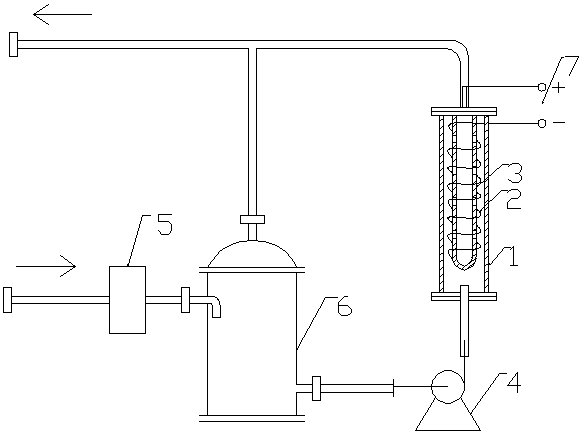Method for treating methanol and formaldehyde industrial wastewater by electrocatalytic oxidation
A technology for electrocatalytic oxidation and industrial wastewater, applied in chemical instruments and methods, water/sludge/sewage treatment, sterilization/microdynamic water/sewage treatment, etc. Formaldehyde wastewater treatment difficulty and other issues, to achieve the effect of low cost, stable properties, and convenient operation
- Summary
- Abstract
- Description
- Claims
- Application Information
AI Technical Summary
Problems solved by technology
Method used
Image
Examples
Embodiment 1
[0026] (1) Etch the porous titanium tube with an outer diameter of 30 mm, a thickness of 2.5 mm, and a length of 200-1000 mm with a mixed solution of acid and alcohol, take it out, ultrasonically clean it, dry it in an oven, and set it aside;
[0027] (2) The germanium bismuth lanthanum coated electrode was prepared by impregnation and coating pyrolysis method. An electrode coating solution A of Ge:Bi:La=100:X:Y (molar ratio) is prepared with a low-carbon alcohol solution as a solvent, wherein the value of X is 1-40, and the value of Y is 1-15. Immerse the etched porous titanium tube in solution A for 1.6 minutes at room temperature, dry the surface solvent in an oven, and calcinate in a heating furnace at 300-500°C for 60 minutes; repeat 5 times;
[0028] (3) Loading TiO by sol-gel method 2 The substrate is the cathode, and a low-carbon alcohol solution is used as the solvent to add a titanium source to prepare a uniform and transparent sol, and then brush coating and therma...
Embodiment 2
[0040] (1) The porous titanium tube with an outer diameter of 30 mm, a thickness of 2.5 mm, and a length of 200-1000 mm is etched with a mixed solution of acid and alcohol, taken out, ultrasonically cleaned, dried in an oven, and set aside;
[0041] (2) The germanium bismuth lanthanum coated electrode was prepared by impregnation method and coating pyrolysis method. Using low-carbon alcohol solution as a solvent, prepare electrode coating solution A with Ge:Bi:La=100:X:Y (molar ratio), wherein the value of X is 1-40, and the value of Y is 1-15. Immerse the etched titanium film substrate in the above-prepared solution A, immerse at room temperature for 1 min, dry the surface solvent in an oven, and calcinate in a heating furnace at 300-500 ° C for 60 min; repeat 5 times;
[0042] (3) The electrode prepared by the above process is used to electrochemically treat wastewater containing methanol and formaldehyde. The anode is the above-mentioned porous titanium-based catalytic acti...
Embodiment 3
[0048] (1) The porous titanium mesh with a length of 8-10 cm, a width of 8-10 cm, and a thickness of 2.5 mm was etched in a constant temperature water bath with a mixed solution of acid and alcohol for a certain period of time, and then ultrasonically cleaned after taking it out, and carried out in an oven. dry, ready for use;
[0049] (2) The nickel-cobalt coated electrode was prepared by impregnation method and coating pyrolysis method. Using low-carbon alcohol as a solvent, prepare electrode coating solution B with Ni:Co=90:Z (molar ratio), where Z value is 1-20. Soak the etched porous titanium mesh in the above preparation solution B, soak for 2 minutes at room temperature, dry the surface solvent in an oven, and calcinate in a heating furnace at 400°C for 60 minutes; repeat 5 times;
[0050] (3) Use the electrode prepared by the above process to electrochemically treat wastewater containing methanol and formaldehyde. The anode is a porous titanium-based catalytic active ...
PUM
| Property | Measurement | Unit |
|---|---|---|
| thickness | aaaaa | aaaaa |
| length | aaaaa | aaaaa |
| length | aaaaa | aaaaa |
Abstract
Description
Claims
Application Information
 Login to View More
Login to View More - R&D
- Intellectual Property
- Life Sciences
- Materials
- Tech Scout
- Unparalleled Data Quality
- Higher Quality Content
- 60% Fewer Hallucinations
Browse by: Latest US Patents, China's latest patents, Technical Efficacy Thesaurus, Application Domain, Technology Topic, Popular Technical Reports.
© 2025 PatSnap. All rights reserved.Legal|Privacy policy|Modern Slavery Act Transparency Statement|Sitemap|About US| Contact US: help@patsnap.com



